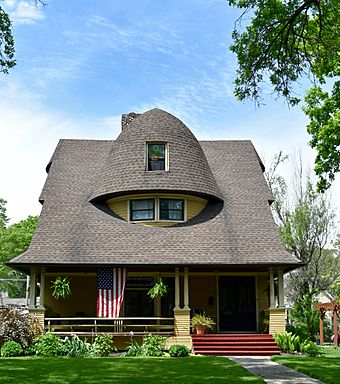West Ninth Streetcar Line Historic District facts for kids
Quick facts for kids |
|
|
West Ninth Streetcar Line Historic District
|
|
 |
|
| Location | W. 9th St. from University Ave. to Hickman Rd. Des Moines, Iowa |
|---|---|
| Area | 11 acres (4.5 ha) |
| Architect | Hallett & Rawson, et al. |
| Architectural style | Late 19th and 20th Century Revivals Late 19th and Early 20th century American movements Late Victorian |
| MPS | Towards a Greater Des Moines MPS |
| NRHP reference No. | 98000377 |
| Added to NRHP | April 23, 1998 |
The West Ninth Streetcar Line Historic District is a special area in Des Moines, Iowa, United States. It's located in the north-central part of the city. This district is named after West Ninth Street, where a streetcar line used to run. The streetcar line went from University Avenue in the south to Hickman Road in the north. This historic area was added to the National Register of Historic Places in 1998. This means it's recognized as an important place in American history.
History of the Streetcar Line
This historic district was most important between 1883 and 1936. This was the time when streetcars used to travel along West Ninth Street. It was the busiest streetcar route in Des Moines during the Victorian era. The area still looks much like it did back then.
The West Ninth Streetcar Line was special because it was one of the first. It used "narrow gauge" tracks, which were narrower than other tracks. It was also unusual for a neighborhood to have more than one streetcar line. This shows how important North Des Moines was as a growing suburb in the late 1800s. The streetcar line helped many new houses get built in the 1880s and 1890s.
The Des Moines Street Railroad Company first built this streetcar line. It was an extension of their downtown route and was called the "Red Line." At first, horses pulled the streetcars. Later, a person named Jefferson S. Polk helped make the line electric. The Red Line eventually reached Crocker Woods by the Des Moines River. It also served the east side of Des Moines and went to a suburb called Capitol Park. The streetcar service on Ninth Street stopped when gas-powered buses took their place.
Buildings and Architecture
Most of the buildings in the West Ninth Streetcar Line Historic District are houses. Many of these houses also have garages or stables nearby. There are 145 buildings in total in the district. About 97 of these buildings are considered "contributing properties." This means they are old enough and important enough to help tell the story of the district.
Most of the buildings are single-family homes. There are also nine buildings that are for multiple families, like double houses or apartment buildings. About 20 buildings are smaller structures like garages. The houses show different building styles from the past. These include the Stick style, Queen Anne, Colonial Revival, American Foursquare, and American Craftsman styles. A few houses also show the Shingle or Prairie School styles. Most of the houses are made of wood, but six of them are built from stone or brick.
The district also has six other buildings that are not houses. These are called "institutional buildings." They are not considered "contributing properties" because they have changed a lot over time. One area in the district used to be the campus for Des Moines University. Later, it became the campus for Dowling Catholic High School. After the high school moved in the 1970s, the main building was taken down. Now, the land is used for different public purposes.



